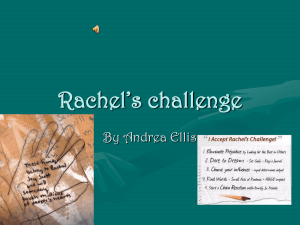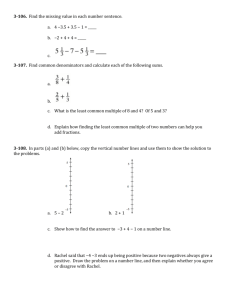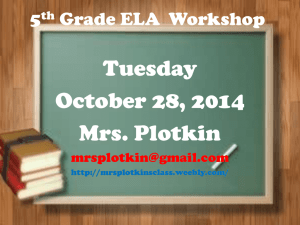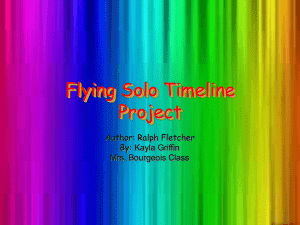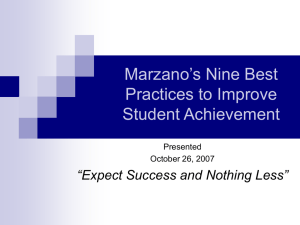Rachie Karu
advertisement
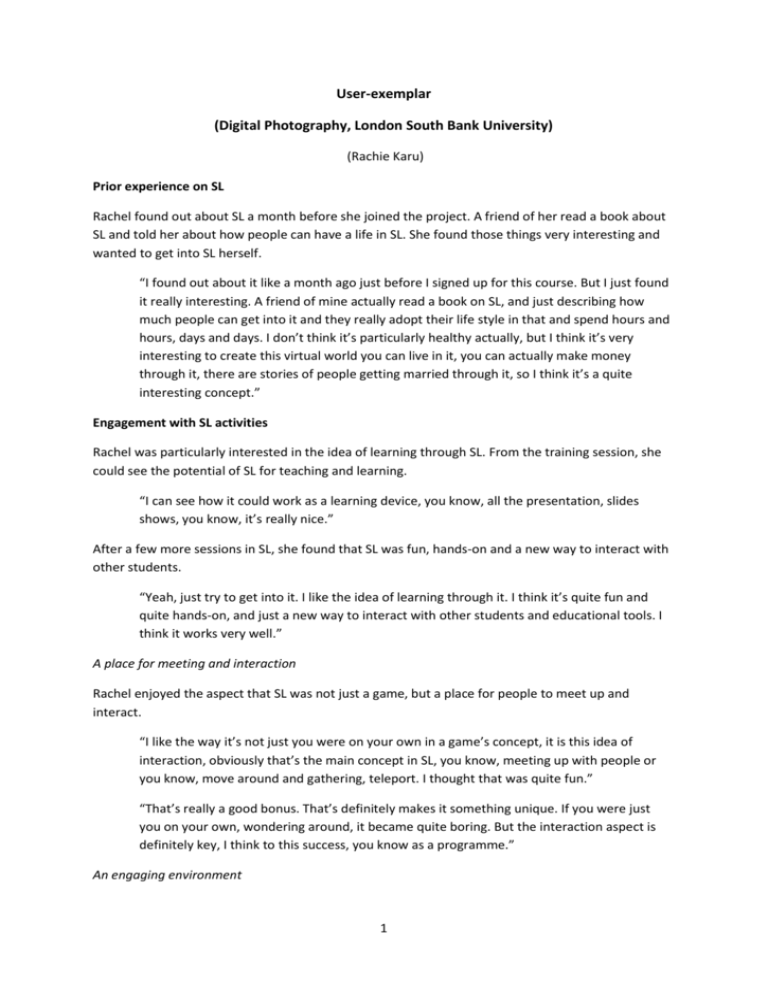
User-exemplar (Digital Photography, London South Bank University) (Rachie Karu) Prior experience on SL Rachel found out about SL a month before she joined the project. A friend of her read a book about SL and told her about how people can have a life in SL. She found those things very interesting and wanted to get into SL herself. “I found out about it like a month ago just before I signed up for this course. But I just found it really interesting. A friend of mine actually read a book on SL, and just describing how much people can get into it and they really adopt their life style in that and spend hours and hours, days and days. I don’t think it’s particularly healthy actually, but I think it’s very interesting to create this virtual world you can live in it, you can actually make money through it, there are stories of people getting married through it, so I think it’s a quite interesting concept.” Engagement with SL activities Rachel was particularly interested in the idea of learning through SL. From the training session, she could see the potential of SL for teaching and learning. “I can see how it could work as a learning device, you know, all the presentation, slides shows, you know, it’s really nice.” After a few more sessions in SL, she found that SL was fun, hands-on and a new way to interact with other students. “Yeah, just try to get into it. I like the idea of learning through it. I think it’s quite fun and quite hands-on, and just a new way to interact with other students and educational tools. I think it works very well.” A place for meeting and interaction Rachel enjoyed the aspect that SL was not just a game, but a place for people to meet up and interact. “I like the way it’s not just you were on your own in a game’s concept, it is this idea of interaction, obviously that’s the main concept in SL, you know, meeting up with people or you know, move around and gathering, teleport. I thought that was quite fun.” “That’s really a good bonus. That’s definitely makes it something unique. If you were just you on your own, wondering around, it became quite boring. But the interaction aspect is definitely key, I think to this success, you know as a programme.” An engaging environment 1 Rachel enjoyed the visual aspect of SL and the freedom of being able to fly without worrying about falling off and getting hurt. She found those aspects quite engaging. “Like the visual aspect of it is really nice, like how you can turn around, how much you can see, like as I said, the movement control of your avatar, how you can move around, obviously the movement control, that the person can fly… and there’re not many constrains for you, not to be too careful about falling off so you’re hurting yourself. So you can just be kind of free, and that’s quite… yeah the visual aspect is really nice, walking about, flying about, and seeing all these things people have been created, really colourful, it’s just kind of interesting for the eyes. All the little gages you got, taking pictures, be able to teleport from one place to another is really nice.” She thought the visual element was particularly important for engaging digital photography students because they are sensitive and responsive to visuals. “We are photography students, we’re all creative artists, visual people that turn on by things that we see, as oppose to a group of people, Math students or something, perhaps a bit difficult, they might not be so inclined to be involved, they might be bored or find it a bit meaningless. But because we’re all visual students, it definitely helped us.” The vastness of SL also invited her to explore and find out more about SL. “And the vastness of it, it’s so huge, you know, you were in there, you were just a tiny little dot in. This is a massive virtual world. It makes you want to find out what else there was. Every place I go, there is something interesting to look at or something interesting, you know, taking pictures of all, so everywhere is gonna be so interesting, I need to see all, it’s a lot to see.” Development of interactive object Rachel found lots of potential of SL for building and creating things that couldn’t be so easily done in real life. “It was nice to see because you could do things you wouldn’t be able to do, building a story cube with these massive blocks, obviously, you wouldn’t have the opportunity to do that.” “I was always consciously aware of the fact because it’s a virtual world, so digital, so computerized, so designed by someone or many people, so that’s what we’re doing our course, designing things and developing things through digital media, so that kind of thing engaged you further because that was just a blank screen until someone designed every single piece of it, so that definitely interested me because that’s we do I suppose.” She found that the group discussion was so engaging and involving because it was through the development of an interactive object. “This is interactive, involving you what’s going on, you know, it’s not like lecturing something, it’s quite easy just sit back, not really being able to pay that much attention, while that keeps you involved, because it amuses you, like it might distract you a little bit, but it keeps you involved in the class what’s going on, so overall it’s definitely benefit, you 2 had a bit laugh for 5 minutes, do something that’s not really part of what you’re meant to be doing in the session, but everyone is still involved, and engaged what’s going on, and then you can go back and doing the task, switch on like 100% motivation, I think it’s really important because people lose concentration very quickly, you only can concentrate for 20 minutes of the time, so it’s really important to keep people interest, and definitely SL does that.” Visual exhibition & gallery Rachel thought that SL offered a visual place for displaying her work. Compared with real life, SL offered an opportunity to run the exhibition with much more freedom and lower cost. “I think Paula said something quite important, interesting about the possibility of putting your work and stuff, just kind of options of what you can do. They’re endless, how are you going to present them and stuff, because the cost and technical aspects in real life, you might not be able to do something, whereas in SL, you can do it because there’s not so many boundaries, and she was saying something about exhibiting our work in a boat and just sailing about with all our photographs and stuff. It’s definitely interesting for that aspect, because you can do almost anything you can think of, you can do with that quite easily, so that’s definitely not so limiting.” Group discussion & negotiation in SL Rachel thought that the group discussion and negotiation went on very well. “I don’t have any problems, we were in there, by a couple of minutes, everyone started the task already… we were just Point a, and Point b, and then doing task, and again that was good.” She was comfortable with talking to people through text. She used Facebook and MSN for quite a long time and found communication through text natural. “I found that quite natural. Especially when we had this programme, you know Facebook around, MSN messengers, I think these things have been around for several years, you know, that’s not too much weird to talk to people that way.” Rachel identified a number of advantages of communication through text. One of them was that the ideas became clearer, more precise and thought through via text, whereas when people spoke, they tended to say without thinking too much. It was also difficult to control the group discussion through voice because people sometimes talked something off the topic and they tried to speak at the same time. Text-based communication through SL offered a platform where everybody’s ideas could be equally heard and fairly judged. Communication through text might help shy people to bring out their ideas. Presence through avatars provided some level of anonymity which might help people to bring out their ideas. 3 It was also good to have a record of what people had discussed if the communication was through text. There were disadvantages about communication through text. Rachel said that the communication could be more formal through text than talking. In real llife, people made more jokes in the conversation. People couldn’t see the body language, facial expressions and hear the voices of each other through text. However, Rachel said there was always a flip side of these aspects. For example, in SL through text, people might focus more on getting the task done instead of joking around and being distracted by the richness of personal cues. Overall, Rachel thought that text-based communication offered more advantages than disadvantages, especially for educational purposes. “I mean obviously, there always going to be advantages and disadvantages, something like that. But definitely I think, on a purely recreational basis of kind having fun going on SL, perhaps, that would be a disadvantage. It’s obviously you can’t see the facial expressions, to get the whole meaning what someone was saying. But in educational purpose, I think it’s really good because it’s not distracting, you can focus on what’s actually said. Anyone’s equal. Anything comes from anyone you take them on the same stand whist, if you don’t purposely do it, in a class when someone says something, you don’t take too much notice because you think, ‘I don’t want to listen to that’, whist through SL, it’s just text coming through your box, and you read it, and it’s all equal, how you perceive that, so that’s quite important.” Rachel’s personal view on group discussion through text in SL was captured in a cognitive map below. 4 7 The ideas become clearer and more precise 8 You only say the key points 6 You say in the head, then think through, then alter it a bit, then type it ... You talk before you think 11 Everybody was talking at the same time 13 We don't get distracted ... We get side-tracked by little conversations 33 You can scrool up and read it if you forget 32 It's good that everything is logged 30 It helps to bring out good quality in people 38 It's harder for people to understand 36 Lose a bit meaning what people try to say 17 It gave everyone an opportunity to be heard 29 SL gives a platform that everyone is on the same level - 12 We're sticking to the point using text ... Not sticking to the point in talking 14 You can see what everyone else said in SL through text 34 People are more conscious about what they're typing - - 10 It's easier to control the group discussion through text - 16 Teacher has to work harder to keep us in control 39 SL is quite good as an educational tool 9 It's much easier for people to receive what you're trying to say through text 35 It's more the formal stuff in text ... Say more joke, funny when talking in real life 37 You don't have their voice or facial expressions 28 SL gives a fresh start 20 You put everyone on the same level ... You would value more from a particular person then the other, although they say exactly the same thing - 26 You have this new avatar 27 You're doing it through computers 19 You judge what someone said on the basis of how they look or their voice is more authoritative or confident 21 It's good to bring out ideas for people who aren't so confident in speaking ... Some people never say anything although they produce really good work 31 There is a record of text-based communication 24 It's easier to type something ... More difficult to stand in front of the class and say something - 25 People worry to say something wrong 23 It's not like they don't have any ideas, but they're a bit shy Identity through avatars Rachel perceived a missing body language and facial expressions through avatars and that created a barrier for the communication. However the barrier didn’t bother her too much because she knew them in real life. When she talked to them through SL, she had a mental picture of them and she actually talked to the real person. The missing body language and personal voice would make a big difference when talking to a stranger in SL. It was difficult to identify the real identity of the person from how he or she presented him or herself through the avatar and the way the avatar interacted. Rachel also felt that SL as well as Facebook and MSN, is less personal than real life. She wouldn’t use SL for having fun with her friends. However, for the same reason, SL could be very useful for educational purpose because it was less distractive for the students. Rachel thought that for this group of students, because they had already known each other, it was actually better to cut out those personal cues so that everybody can focus on the group discussion and get the job done. It wasn’t difficult for Rachel to tell who the person was behind the avatar once they started interaction in SL and getting more familiar with each other. Rachel observed that people didn’t really change their personality when they communicated in SL through avatars. Their characters came through the interaction and that made things easier to tell who the person was behind the avatar. Rachel observed that people made more jokes and humours in the later sessions just like what they 5 did in real life. Their characters came through the text despite the fact they presented themselves through avatars. Rachel made her avatar randomly. She observed that other students also made their avatars on a basic level. She thought that people didn’t really use the freedom to create their avatars as much as they wanted them to be because they knew they used SL for research purpose. Another reason that people didn’t really create their avatars freely was because they know each other in real life and they were worried being judged by others on how their avatars look. Rachel’s personal views on the impact of presence through avatars on identities and group discussion were captured in a cognitive map below. 55 SL is good for edcuation 58 I can almost recognize who is who just from what they've chosen for their avatars on screen 62 People don't spend time and created their avatars on a basic level ... People spend time on doing hair and cloth, and make their avatar look fancy as they w 64 We're using SL for research ... Using SL for fun 66 People worried being judeged by others on how their avatars look 63 I can recognize who is who once I got more familar with how the avatars interact 61 Their personality is mingling with their avatar 60 I can see their characters coming through the dialogues, humour and funny things people're saying 65 We all know the real person ... Being an anonymous person 67 We're sitting in the same room next to each other 47 I found it stranger ... Comfortable with people you know 45 The conversation became robotic ... Same interesting with people you know 50 I don't know their characters and style of talking and writing ... I got them in my head how they say something in text and real life and facial expressions 44 I don't know who they were, male or female, how old they were, where in this world they were from 59 They're students from my course, we're in the same classroom 49 I don't really know their meanings, whether they're joking ... You know the meaning 42 I only get this blank text from this avatar ... I got their mental images inheritedly in my brain 40 Missing body language and facial expressions puts a barrier between the actual person and the person behind the avatar 52 I don't think SL is for recreation, meeting up and having fun with my friends 53 I don't like to speak to friends very oftern on Facebook and MSN ... I like to talk to them on the phone or f2f 51 I found SL less personal like Facebook and MSN ... Talking somebody on the phone or face-to-face is personal 54 SL is useful for work-based thing you don't need too put emotion and character, but focus on get things done 57 It's good to cut out the distraction 56 People focus on the task and not talking anything else ... People spend lots of time socializing 43 Speak to people I don't know in SL ... Speak to people I know in SL Socialization in SL Rachel talked to others quite a lot in real life during these SL sessions. The things they talked about were mainly to do with technical skills such as how to do things and how to get to a place. “But I think the majority of that was kind of saying, ‘I don’t understand’, ‘how do you do that’, or ‘how did you over there’, or ‘can you show me how you take a picture’, or something, it’s more technical thing, and maybe that’s the same for the others. In the second and fourth week, we get a better understand of how it all works, so you can just concentrate on what you’re doing, you have to communicate through that way.” “Yeah, I went to… she just send me the link she took some pictures of monkeys. I was sitting next to her so I could see that from her computer screen and I said, ‘where are you? I want 6 to see the moneys’. Then she just send me to teleport link to teleport me where she was. So that was quite fun.” “I mean if it was like within SL, ‘I want to go to that place you were last week, how to get there’, then their avatar can show your avatar, something like, ‘follow me’, or send you a teleport, so you can technically help people through SL. But at the very beginning, it was more like doing something to do with toolbar, so their avatar couldn’t point to your toolbar, so it’s more obvious to them just look your screen and say, ‘press file, search’, that kind of thing. But once you kind of get over that, learn the basics, it was really fundamental stuff you need to get the actual communication, then after that, you can learn through SL.” She thought that everyone sat in the same room next to each and use SL together was fun and amusing. “That was quite funny. Everyone would be laughing at the same time, you know in real life through this little joke that is happening in SL. That was quite amusing.” “And that was nice to have all the other people that I knew in SL at the same time because if someone in the room found something, then we talked to us through SL say, ‘oh, I found something really cool! Come and look at this.’ and send the link or whatever, that made it really quite easy.” Learning how to use SL Learning basic skills Rachel found that the training guide was very useful. It helped her to familiarize herself with the basic movement controls on the keyboard. “I found that helpful, definitely. I just practising it, because it’s just educating your fingers, like not having to think, ‘oh, go forward, go backward’, just doing it…It’s what you’re starting, then you don’t have to think about that anymore, involved in your surroundings…you were just naturally going through the controls and don’t think about that so much.” She read through the training guide thoroughly point by point, and practised those basic skills such as movement, teleporting and communicating on her own. “I just read through it. Then basically went through point by point, and then when on SL saw the correlations between the two, then practise it basically. I got practising a few hours this week. It’s been quite fun, just wondering about, just go places and taking pictures, things like that.” “Yeah, the basic movement, like walking around, teleporting, and how you communicate with one or another, that sort of thing.” After practising basic skills on SL for a few hours , Rachel still found that the basic movement was hard at the beginning. 7 “I found it quite hard to get the basics of it. Last week it was kind of practising, getting this little avatar, whatever, I found it hard to move around and understand how it works. But I think that’s just one of little hurdles. Then it’s kind of quite open to you.” “It does take a quite long time just navigate. That’s only the downside at the moment for me, if I was doing educational things through it, I could spend a good few hours in SL only get an equivalent of half an hour’s real learning, just because it takes a little bit time to get on places, but I think that maybe that will be quicken, you know with my knowledge of the programme…” She observed that other students had the same problems during the first SL session. “We’re were all still in the same room and everyone is kind of bumping into each other, getting confused and having not knowing how to get into this. It’s quite amusing, and everyone has done a bit practising before we go to the session, but still we found it a little bit hard… but I think I’m sure like this week we’ll have more logical stance on it and be much better, hopefully.” Although Rachel found basic movement was a bit harder for her, she thought that it was good to have a certain level of sophistication to be able to do more complicated things in SL. “They were meant to be that complicated because if it was just a straightforward backward and forward, then you wouldn’t be able to do very much of it. So you need to be able to look around to be able to change the camera angles, and this sort of thing, to make it more comprehensive, to make it more realistic.” Rachel didn’t play computer games very much. She thought that it could be much easier for somebody who was engaged with playing computer games a lot. “So it’s just a bit of getting used to it. I don’t play computer games, but I know some of my friends are always on computers or play-stations, or things like this, maybe they would find it easy to pick it up, just from a more, you know hands-on computerized way of thinking. I don’t generally do that sort of thing. I just found a little bizarre to begin with, but now it’s fine.” She said that for her parent’s generation, it would be much harder for them to get used to this idea and it would take lots of time to get them started doing something in SL. “I know for instance, if it were for my parents, they’re not that old, they’re like 50’s, if they try to get in SL, they would find it very weird and strange because they only have mobile phones, and they don’t really use computers, games that sort of thing, so it could be very hard for them, it could take them up to a few weeks before they started doing it.” However, for her generation, being able to use the 3-D virtual world is the way to look forward. It’s also good for her to be prepared for that change. “But, you know, our generation with technology … this is the way the world is moving forward really. So people are prepared for that, and assuming that as it was, so… I think it’s really a good idea.” 8 Rachel really enjoyed the face-to-face training session. First of all, it was fun and interesting to see each other’s avatars. “I just found it really enjoyable. It was really interesting. The time went really quickly, and the guy is really amusing. It was really a good fun to see our characters.” She learned about new functions in SL, such as landmark which she found very useful. “What I supposed every time you go into it, it becomes a little bit familiar with way you can go, you can save the locations you’ve been before that you thought good, so you can get there without too much trouble because obviously it’s this mad massive virtual world, you know several levels and it’s really hard to find things that you’ve found once without save them. That option is a good idea.” It was good to be shown how to do things by somebody who had plenty of experience on SL. “I think it definitely helped… because he was saying when he first went on SL, there was no orientation island to start with, and obviously you didn’t have anyone to show you how this is all done, it took him ages to figure out even how to move, and realize he had a little… you know, the map, search options, and stuff. So it definitely helped. He just took away a couple of hours to wondering around, just say, ‘this is how you do it’, showing us from the screen, make it much simpler. So that definitely did help.” It was also good to be guided through SL by a tutor who can keep students on track. “I think it worked with me to actually learn material through a course or something, but obviously there is a slight danger that you get distracted because you’re too busy into changing hair styles, different cloths, going little other things that was on offer. But as long as you can have your teacher there in SL with you and there was a time slot that you wouldn’t be able to wonder off kind of things.” Difficulties in using SL She didn’t experience many technical problems when using SL, apart from moving things around was a bit difficult for her at the beginning. But with some practice, she made progress quickly on SL. “No, not really, just obviously at the beginning, things like technical problems like moving things around, and stuff, but that was soon cleared up. Once that is kind of more obvious, I think it’s all quiet, you can do what you want, just how much you want to progress on that. I mean I don’t even know half, even tiny bit of SL, I’ve been on it for 10 times also, so I know there is a lot to discover, change and involve….but I didn’t really find any problems apart from the initial, not knowing how to use it.” Another difficulty Rachel experienced was how to search and find useful information on SL. It took her a little while to figure out that SL is not a place simply for replication those places in real life, but a unique place on its own. “I did find it quite hard because first I was a bit confused because SL is not just a second world. It’s the only unique world, so I was kind of looking for places, search and type in, you 9 know London, Eiffel Tower, Paris, none of these things coming up, and I found that bizarre, then I realized they’re just unique islands people have built.” “I did find quite hard to find stuff, but then once I found, I kind of type into theme park, something that came up with wonderland….like shops, little things you can do, I took pictures there. I thought it was really fun, but it was a little bit… what you need to get over the concept of it.” She identified a limitation in taking photos in SL from a photographer’s point of view. In real life, the job of a photographer is to take a portrait of a person by capturing his or her expressions or what you want them to be in a more dynamic way, whereas in SL it’s all about to capture what has been created there already. For this reason, it’s harder to distinguish the work of one photographer from another in SL because they all look very similar. “It’s kind of preliminary kind of photography, it’s kind of go out and taking pictures of what you see, so you just shooting and getting pictures, which is good and building up your collection, they’re nice images visually, but I just think it’s not really, it’s not your art that your capturing, you’re just recording someone else’s design, you know, when you’re taking a picture of someone’s avatar, you’re just recording what someone else has made of that avatar, whereas in real life, you’re going to take a portrait of a person, and obviously that what they look like, that’s how they would ….this world, but then you capture their expression, you capture what you like you want to see them, but obviously again, I did find, especially in the last week of the course with the technical aspect, I’m realizing that you can change the time of the day, and that fits the light and when you got really progressed with the camera control, get out really zoom in and stuff, then you can get really nice qualities of images, but it is a little bit flat because it’s on a virtual level.” “I just think taking pictures, I mean capturing what was already there, and obviously, that is what photographer is. But because you got less control of your camera in terms of just the function or stuff, it’s harder to distinguish your work from the others, like when we made the story cubes, I found it quite notable that everyone’s images are on the same kind of level because we were all using exactly the same camera, taking pictures of exactly the same kind of graphically design things, and SL is massive, still some of us getting the same images, so I found that really bizarre, people went to the same place together or something, but they all look very similar, whereas if we all went out in real life, obviously we do this and we come back to the classroom, ‘right, this is what we got’, everyone’s work is completely different and they chose different…techniques, colour techniques, what cameras they are using, exposure time, and technical aspects of photography, and they come out and look very different. In SL, they’re all look quite similar, only the subject matter differentiate. So from that aspect I think it’s a little bit, limiting. But then obviously you can take pictures in real life and upload them into SL, then you got endless options again.” On the whole, Rachel’s initial experience in SL was quite encouraging. She thought that SL was such an exciting and interesting place to look around and had great potential as a learning environment. 10 “I don’t know, also obviously I’ve only been there a few times, it was quite exciting, I want to look around. Once you got over that, the first initial excitement of it, you could just going into your classroom in SL and you know, learn for an hour for online students.” She thought that the level of complexity of SL engaged learners enough to carry on, not to give up. “Yeah, but engaged you enough to carry on. It’s not, you know, you’re the beginner, and it’s too hard and you just give up. It engaged you, interested you, so you want to get there. And I’m sure, you know that happens really quickly, there is a huge difference in my ability through SL just in the last two weeks, I’ve only been there a couple of times. So I think if you were going there a few times a week for a learning purpose, within 2 weeks, you have no problems at all for the technical aspect of it. So I think, and it needs to be that level of complexity to be interesting, because otherwise, it’s too easy. People don’t, people like challenge.” Although for this small group of six volunteers who didn’t find SL very difficult to learn, Rachel didn’t think that it would be too much challenging for other students in her class. They’re all technically on the same level. “I don’t think, just knowing the group who did in SL and knowing everyone else in my course, definitely, that wasn’t the top technical people that volunteer themselves. It was a random mixture of the class that turn out, so I know when I think about people in my course, not have problems with SL.” “I mean some people are gonna find it a little harder than others, that’s always gonna happen, but I’m sure everyone would be able to get there relatively quickly, just on a equal level with us, we’re just kind of good, average of the rest of the group.” 11
